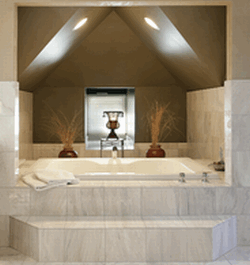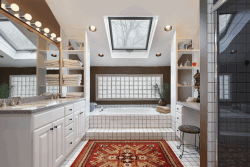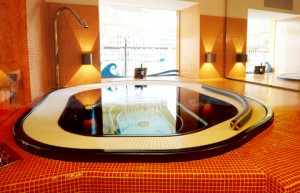Bath Lighting Fixtures: Relaxation and Luxury
Bath lighting fixtures allow you to make bathing relaxing and luxurious.
Bath lighting fixtures can make your bathing experience far more relaxing and enjoyable. By combining the right types of lighting fixtures in the right colors and in the right position, you can create an oasis around your bathtub that provides luxury, but at the same time, integrates well with the rest of the room. In a way, the bath is unique in the bathroom. Until the last fifty years or so, bathrooms were usually decorated in an almost exclusively functional way. That is, very little effort was put into making the room attractive. To some extent, this was a correct assumption. People rarely spend much time in the bathroom. In fact, the introduction of showers made this even more the case: getting clean became even more functional.
Bathing, however, is an exception. Bathing has always been seen as a luxurious and relaxing event, even though it, of course, has a function. People like to enjoy their baths and spend some time bathing. As a result, the bath is really the only part of the bathroom where people spend time doing something they want to enjoy in its own right.
Principles of Bath Lighting Fixtures

These lights are located perfectly. Notice how they cause no glare, reflect downward off the opposing surface and pick up some warmth from the brown paint.
Recessed lights are especially bad for this, but if you have recessed lights you would rather not uninstall, you should install what is called a “louver” over the fixtures. A louver directs all the light in a single direction, so that it does not shine directly downward. One good option for redirecting light with a louver is to shine it onto the wall of the bathroom, where it will reflect and fill the bathroom with some ambient light.
If lights aren’t to go overhead, where should they go? One good place for bath lighting fixtures is to place them on the wall near the bathtub. You can use wall sconces, which will shine light either upward or sideways and not get into the eyes of bathers. Alternatively, you could use cove lights. Cove lights are placed in small “coves” near the bathtub. They produce a very nice quality of light, because the large number of surfaces surrounding the light source produce ambient light that reflects in all directions.
Overall, the main principle is that you should not use bath lighting fixtures to light the bath directly. People’s skin looks best under softer, ambient light, rather than the shadowed light created by direct light sources. Instead, bounce light off of the walls and ceiling, so that soft light lands on the bathing area.
Color and Bath Lighting Fixtures
Human skin actually doesn’t look especially good under white light. Skin looks more attractive when it looks healthier, and we look healthier based on the amount of blood that flows under our skin (within limits). As a result, people look best when they are under lights that bring out the red in their skin tones, not the other pigments. Of course, you don’t want to just shine red lights on people, as that would look silly. However, a pink light will provide the color that will look most attractive on human beings.For years, this wasn’t really an issue. The only type of light available for standard home use was the incandescent bulb, and incandescent light bulbs are warm. As a result, human beings looked very good under most home lighting. However, in recent years, a number of alternative types of light bulbs have become available, and many homeowners have switched to them because of the energy savings. In fact, in many jurisdictions, incandescent light bulbs are being completely phased out.
Fortunately, fluorescent light bulbs are now available in a number of different colors, including colors that mimic the tones provided by incandescent lighting. In order to find such bulbs, look for those called “warm white” or “soft white”. These two colors are intended to mimic the warm lighting of incandescent bulbs.
In addition, many people like to use even warmer colors. There are a couple of ways to do this. One is to use tile or paint around the bathtub that is a warm color itself. As the light reflects off of the walls, the light will be warmed, increasing the amount of red that is brought out in skin tones.
Finally, there is, of course, the option of candles. Candles, because they are colder than light bulbs, provide redder light. (One of the strange things about lighting terminology is that hotter light sources produce cooler colors and vice versa). These can be used on their own while bathing, in which they simply replace your lighting design, or they can be used to augment your lighting by providing warmer colors and some motion.
Candles and Safety
If you use candles at all, there are some important safety considerations that should be taken into account. There are two problems that candles can produce: fire and slippage.
- Fire: The main danger with candles is the possibility of hair catching on fire, though of course, other burns are possible. No matter what kind of hair you have, you should not place candles near your head, as your hair can either catch on fire or dry out from prolonged exposure. If you have long hair, you even need to be careful of candles on the side of your tub. When sitting up or getting into the tub, it is very easy for your hair to fall onto the candles, creating a fire hazard. Similarly, be sure not to put candles near curtains or towels.
- Slippage: A problem with candles or any other dim lighting design is that you run the risk of not properly seeing as you enter and leave the tub. This can create falls, especially after the bath when your feet are wet. To prevent this, you should have some other lighting source that clearly illuminates the floor or steps next to the bath tub. Choices could include some LED lights for stairs that let you clearly see them, some safety lights in plugs near the floor or simply turning on some other lights in the bathroom.
Integrating Your Bath Lighting Fixtures

While the light in this bathroom is well integrated, no one will be able to bathe during the day because of all the glare.
One option is to have some overhead lighting over the bath that is on a separate switch and that you turn off when the bath is in use. This means that, when no one is bathing, you have a completely integrated lighting plan. The main difficulty with this is that your bathroom will cease to be integrated when someone is bathing.
Another option is to use lighting in the rest of your bathroom that resembles the lighting used in your bathtub. If you use sconces by your bathtub, you can put sconces in the rest of the room. If you use cove lighting, you can put cove lighting. Then, when someone is bathing, you can turn off all of the overhead lighting and keep an integrated lighting design.
Putting It All Together
Bath lighting fixtures provide you with the opportunity to create a luxurious bathing environment, provided they are integrated well and safely:
- Avoid overhead lighting in the bathing area, at least when people are bathing.
- Use warm colors in the bathing area, including incandescent bulbs, warm fluorescent bulbs or candles.
- Be careful with candles as they can be a fire and tripping hazard.
- You can integrate your bathroom lighting by using separate switches for overhead lighting and by using ambient lighting in the rest of the bathroom.
With the proper lighting, the bathtub can become a favorite place in the home.
Back from Bath Lighting Fixtures to Bathroom Lighting Design
